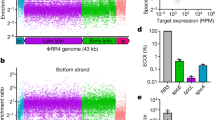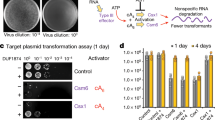Abstract
Since their discovery, giant viruses have revealed several unique features that challenge the conventional definition of a virus, such as their large and complex genomes, their infection by virophages and their presence of transferable short element transpovirons1,2,3,4,5. Here we investigate the sensitivity of mimivirus to virophage infection in a collection of 59 viral strains and demonstrate lineage specificity in the resistance of mimivirus to Zamilon6, a unique virophage that can infect lineages B and C of mimivirus but not lineage A. We hypothesized that mimiviruses harbour a defence mechanism resembling the clustered regularly interspaced short palindromic repeat (CRISPR)-Cas system that is widely present in bacteria and archaea7,8,9,10. We performed de novo sequencing of 45 new mimivirus strains and searched for sequences specific to Zamilon in a total of 60 mimivirus genomes. We found that lineage A strains are resistant to Zamilon and contain the insertion of a repeated Zamilon sequence within an operon, here named the ‘mimivirus virophage resistance element’ (MIMIVIRE). Further analyses of the surrounding sequences showed that this locus is reminiscent of a defence mechanism related to the CRISPR–Cas system. Silencing the repeated sequence and the MIMIVIRE genes restores mimivirus susceptibility to Zamilon. The MIMIVIRE proteins possess the typical functions (nuclease and helicase) involved in the degradation of foreign nucleic acids. The viral defence system, MIMIVIRE, represents a nucleic-acid-based immunity against virophage infection.
This is a preview of subscription content, access via your institution
Access options
Subscribe to this journal
Receive 51 print issues and online access
$199.00 per year
only $3.90 per issue
Buy this article
- Purchase on Springer Link
- Instant access to full article PDF
Prices may be subject to local taxes which are calculated during checkout

Similar content being viewed by others
References
La Scola, B. et al. A giant virus in amoebae. Science 299, 2033 (2003)
Koonin, E. V. & Dolja, V. V. Virus world as an evolutionary network of viruses and capsidless selfish elements. Mol. Biol. Rep. 78, 278–303 (2014)
Forterre, P. Giant viruses: conflicts in revisiting the virus concept. Intervirology 53, 362–378 (2010)
La Scola, B. et al. The virophage as a unique parasite of the giant mimivirus. Nature 455, 100–104 (2008)
Raoult, D. How the virophage compels the need to readdress the classification of microbes. Virology 477, 119–124 (2015)
Gaia, M. et al. Zamilon, a novel virophage with Mimiviridae host specificity. PLoS ONE 9, e94923 (2014)
Makarova, K. S. et al. An updated evolutionary classification of CRISPR-Cas systems. Nature Rev. Microbiol. 13, 722–736 (2015)
Makarova, K. S., Wolf, Y. I. & Koonin, E. V. Comparative genomics of defense systems in archaea and bacteria. Nucleic Acids Res. 41, 4360–4377 (2013)
Marraffini, L. A. CRISPR-Cas immunity in prokaryotes. Nature 526, 55–61 (2015)
Barrangou, R. & Marraffini, L. A. CRISPR-Cas systems: prokaryotes upgrade to adaptive immunity. Mol. Cell 54, 234–244 (2014)
Bickle, T. A. & Kruger, D. H. Biology of DNA restriction. Microbiol. Rev. 57, 434–450 (1993)
Pourcel, C. & Drevet, C. in CRISPR-Cas Systems 33–59 (Springer, 2012)
Seed, K. D., Lazinski, D. W., Calderwood, S. B. & Camilli, A. A bacteriophage encodes its own CRISPR/Cas adaptive response to evade host innate immunity. Nature 494, 489–491 (2013)
Raoult, D. TRUC or the need for a new microbial classification. Intervirology 56, 349–353 (2013)
Filée, J. & Chandler, M. Gene exchange and the origin of giant viruses. Intervirology 53, 354–361 (2010)
Boyer, M. et al. Mimivirus shows dramatic genome reduction after intraamoebal culture. Proc. Natl Acad. Sci. USA 108, 10296–10301 (2011)
Raoult, D. & Boyer, M. Amoebae as genitors and reservoirs of giant viruses. Intervirology 53, 321–329 (2010)
Zhang, J., Kasciukovic, T. & White, M. F. The CRISPR associated protein Cas4 is a 5′ to 3′ DNA exonuclease with an iron-sulfur cluster. PLoS ONE 7, e47232 (2012)
Sobhy, H., La Scola, B., Pagnier, I., Raoult, D. & Colson, P. Identification of giant Mimivirus protein functions using RNA interference. Front. Microbiol. 6, 345 (2015)
Slimani, M., Pagnier, I., Raoult, D. & La Scola, B. Amoebae as battlefields for bacteria, giant viruses, and virophages. J. Virol. 87, 4783–4785 (2013)
Makarova, K. S., Grishin, N. V., Shabalina, S. A., Wolf, Y. I. & Koonin, E. V. A putative RNA-interference-based immune system in prokaryotes: computational analysis of the predicted enzymatic machinery, functional analogies with eukaryotic RNAi, and hypothetical mechanisms of action. Biol. Direct 1, 7 (2006)
Yutin, N., Raoult, D. & Koonin, E. V. Virophages, polintons, and transpovirons: a complex evolutionary network of diverse selfish genetic elements with different reproduction strategies. Virol. J. 10, 158 (2013)
Besemer, J. Lomsadz, A. & Borodovsky, M. GeneMarkS: a self-training method for prediction of gene starts in microbial genomes. Implications for finding sequence motifs in regulatory regions. Nucleic Acids Res. 29, 2607–2618 (2001)
Altschul, S. F. et al. Gapped BLAST and PSI-BLAST: a new generation of protein database search programs. Nucleic Acids Res. 25, 3389–3402 (1997)
Edgar, R. C. MUSCLE: multiple sequence alignment with high accuracy and high throughput. Nucleic Acids Res. 32, 1792–1797 (2004)
La Scola, B., Mezi, L., Weiller, P. J. & Raoult, D. Isolation of Legionella anisa using an amoebic coculture procedure. J. Clin. Microbiol. 39, 365–366 (2001)
Mba Medie, F., Ben Salah, I., Henrissat, B., Raoult, R. & Drancourt, M. Mycobacterium tuberculosis complex mycobacteria as amoeba-resistant organisms. PLoS ONE 6, e20499 (2011)
Acknowledgements
We thank S. Benamar, A. Caputo and C. Robert for technical support, and L. Pinault for her assistance on protein production.
Author information
Authors and Affiliations
Contributions
A.L., B.L. and D.R. conceived the project and designed the study and experiments; A.L., M.B., P.P., B.L. and D.R. analysed the results; A.L. and D.R. wrote the manuscript. All authors read and approved the final manuscript.
Corresponding authors
Ethics declarations
Competing interests
The authors declare no competing financial interests.
Extended data figures and tables
Extended Data Figure 1 Histogram depicting the replication of Zamilon and Sputnik 3 DNA in Mimiviridae after its phylogenetic classification into lineages A, B and C.
The replication of each virophage was measured after 24 h using qPCR. The term Δ CT corresponds to the difference between the CT value specific to virophage at H0 and H24.
Extended Data Figure 2 The MIMIVIRE defence system.
a, A comparative model between prokaryotic CRISPR–Cas system and the viral MIMIVIRE system in APMV-A. b, The chromosomal environment of Mimiviridae lineage A is illustrated using mimivirus as an example. This organization is conserved across all APMV-A genomes. The 28-nucleotide-long Zamilon insert sequence is AATCTGATAATGAATCTGATAATGAATC, and the derived 15-nucleotide repeated unit is TGATAATGAATCTGA. The four repeats units are separated by 9, 48 and 63 nucleotides, respectively.
Extended Data Figure 3 Agarose gel electrophoresis of different DNA products treated with and without nuclease and/or helicase enzymes.
C, control; N, nuclease treatment for 2 h; H, helicase treatment for 2 h; H+N, helicase and nuclease treatment for 2 h; H*, helicase treatment for 2 h followed by heating at 94 °C for 10 min; H+N*, helicase and nuclease treatment for 2 h followed by heating at 94 °C for 10 min.
Extended Data Figure 4 Phylogenetic trees based on the sequences of the two Cas proteins.
a, R350. b, R354.
Supplementary information
Supplementary Information
This file contains Supplementary Tables 1-3. (PDF 156 kb)
PowerPoint slides
Rights and permissions
About this article
Cite this article
Levasseur, A., Bekliz, M., Chabrière, E. et al. MIMIVIRE is a defence system in mimivirus that confers resistance to virophage. Nature 531, 249–252 (2016). https://doi.org/10.1038/nature17146
Received:
Accepted:
Published:
Issue Date:
DOI: https://doi.org/10.1038/nature17146
This article is cited by
-
Phylogenetic Analysis of Anti-CRISPR and Member Addition in the Families
Molecular Biotechnology (2023)
-
Incomplete tricarboxylic acid cycle and proton gradient in Pandoravirus massiliensis: is it still a virus?
The ISME Journal (2022)
-
CRISPRs in the human genome are differentially expressed between malignant and normal adjacent to tumor tissue
Communications Biology (2022)
-
A virophage cross-species infection through mutant selection represses giant virus propagation, promoting host cell survival
Communications Biology (2020)
-
Exploration of the propagation of transpovirons within Mimiviridae reveals a unique example of commensalism in the viral world
The ISME Journal (2020)
Comments
By submitting a comment you agree to abide by our Terms and Community Guidelines. If you find something abusive or that does not comply with our terms or guidelines please flag it as inappropriate.



